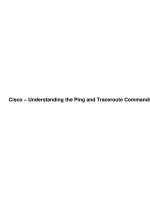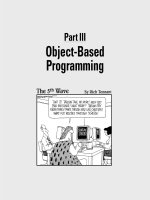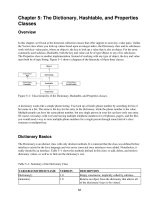The Vector and Stack Classes
Bạn đang xem bản rút gọn của tài liệu. Xem và tải ngay bản đầy đủ của tài liệu tại đây (126.15 KB, 26 trang )
Chapter 3: The Vector and Stack Classes
Overview
Arrays are good when you know the size of your collection and when all the elements in a collection are of
the same type. However, what are you to do if you need a dynamically growing structure but you don't
necessarily know the final size in advance? This is where the Vector class comes in handy. In addition to the
Vector class, Java provides a Stack class for the familiar last−in, first−out data structure.
Figure 3−1 shows the current hierarchy for these two classes. With the Java 2 platform, version 1.2 release,
this structure changed considerably with the introduction of the Collections Framework. Figure 3−2 shows the
original, more simplified look of the class hierarchy from both Java 1.0 and Java 1.1. The 1.3 release remains
the same as the 1.2 release shown in Figure 3−1.
Figure 3−1: The Vector and Stack class hierarchy.
Figure 3−2: The Java 1.0/1.1 Vector and Stack class hierarchy.
Vector Basics
You can think of Java vectors as dynamically sized arrays with synchronized access. They prove to be very
useful if you don't know the size of the array in advance, or you just need one that can change sizes over the
lifetime of a program. Any object can be stored within a vector: these items are called elements. The one
exception is that primitive data elements may not be stored in vectors, but since they aren't objects, this isn't
really an exception.
The Vector class provides multiple constructors and many different methods to create, access, and modify the
21
data structure. These are listed in Table 3−1.
Table 3−1: Summary of the Vector Class
VARIABLE/METHOD
NAME
VERSION DESCRIPTION
Vector() 1.0 / 1.2 Constructs an empty vector of the appropriate initial size.
capacityIncrement 1.0 Size increment for increasing vector capacity.
elementCount 1.0 Number of elements within a vector.
elementData 1.0 Internal buffer for vector elements.
modCount 1.2 From AbstractList: used by iterator to check for concurrent
modifications.
add() 1.2 Adds an element to a vector.
addAll() 1.2 Adds a collection of elements to a vector.
addElement() 1.0 Adds an element to the end of a vector.
capacity() 1.0 Returns the capacity of an internal buffer for a vector.
clear() 1.2 Clears all elements from a vector.
clone() 1.0 Creates a clone of a vector.
contains() 1.0 Checks if the vector contains an element.
containsAll() 1.2 Checks if the vector contains a collection of elements.
copyInto() 1.0 Copies elements of the vector into an array.
elementAt() 1.0 Returns an element at a specific position.
elements() 1.0 Returns an object from the vector that allows all of the vector's
keys to be visited.
ensureCapacity() 1.0 Ensures the capacity of an internal buffer is at least a certain size.
equals() 1.2 Checks for equality with another object.
firstElement() 1.0 Returns the first element within a vector.
get() 1.2 Returns an element at a specific position.
hashCode() 1.2 Returns the computed hash code for a vector.
indexOf() 1.0 Searches for an element within a vector
insertElementAt() 1.0 Inserts an element into the vector.
isEmpty() 1.0 Checks if the vector is empty.
iterator() 1.2 Returns an object from the vector that allows all of the vector's
elements to be visited.
lastElement() 1.0 Returns the last element within a vector.
lastIndexOf() 1.0 Searches from the end of a vector for an element.
listIterator() 1.2 Returns an object from the vector that allows all of the vector's
elements to be visited sequentially.
remove() 1.2 Clears a specific element from the vector.
removeAll() 1.2 Clears a collection of elements from the vector.
removeAllElements() 1.0 Clears all elements from the vector.
removeElement() 1.0 Clears a specific element from the vector.
Chapter 3: The Vector and Stack Classes
22
removeElementAt() 1.0 Clears an element at specific position from the vector.
removeRange() 1.2 Clears a range of elements from the vector.
retainAll() 1.2 Removes all elements from the vector not in another collection.
set() 1.2 Changes an element at a specific position within the vector.
setElementAt() 1.0 Changes an element at a specific position within the vector.
setSize() 1.0 Changes the size of an internal vector buffer.
size() 1.0 Returns the number of elements in a vector.
subList() 1.2 Returns a portion of the vector.
toArray() 1.2 Returns the elements of a vector as an array.
toString() 1.0 Converts vector contents into a string.
trimToSize() 1.0 Trims the capacity of internal buffer to actual size.
Note Tables will list inherited methods where appropriate. However, they will not list those methods inherited
from Object unless overridden. Protected variables and methods are displayed in italics.
With the Java 1.0.x and Java 1.1.x versions of this class, many of the methods were flagged as final. That is
no longer the case. You can now subclass Vector and override all methods.
Creating Vectors
You can use one of four constructors to create a Vector. For the first three constructors, an empty vector is
created with an initial capacity of ten unless explicitly specified. When that space becomes too small, the
vector will double in size unless a different capacity increment is specified.
public Vector()
public Vector(int initialCapacity)
public Vector(int initialCapacity, int capacityIncrement)
The reason for the different constructors is basically performance. If you know the approximate size
beforehand, try to size the vector to that size to start. Otherwise, each time the vector size exceeds its capacity,
a new internal array is created, which copies all the original elements to the larger new array. Creating a new
array and copying the elements takes time, thus increasing the time it takes to add elements to the array. See
the later section "Sizing Vectors" for more information on sizing and capacity.
Note An IllegalArgumentException will be thrown if the initial capacity sent to the constructor is negative.
The final constructor copies the object references in a different collection to initialize the vector:
public Vector(Collection c)
This effectively makes a shallow copy of the original collection. The new vector is sized to be 10% larger than
the number of elements in the original collection.
Basically, you can convert the elements of any collection (that implements Collection) into a Vector. One
specialty collection will be mentioned here, though. If you'd like to create a vector from an array, there is a
helper method available: The asList() method of the Arrays class will create an object you can pass through to
the Vector constructor, as shown here:
Vector v = new Vector(Arrays.asList(array));
You'll learn more about the Collection interface in Chapter 7 at the beginning of Part Two of this book.
Creating Vectors
23
Adding Elements
Once you've created the vector, the next step is to put elements in it. There are six different ways to do this.
Adding at the End
The first set involves the single−argument add() and addElement() methods as you see here:
public boolean add(Object element)
public void addElement(Object element)
These methods are essentially the same—both add the element to the end of the vector. The difference is that
add() will always return true, while addElement() has no return value.
To demonstrate how you might use these methods, the following will fill up an array with all the elements
passed from the command line:
import java.util.Vector;
public class InsertVector {
public static void main (String args[]) {
Vector v = new Vector();
for (int i=0, n=args.length; i<n; i++) {
v.add(args[i]);
}
}
}
Tip Since an Object can be a null reference, the element added to a vector can also be
null.
Adding in the Middle
While the first two methods always add elements to the end of the vector, there are times when you wish to
insert elements at arbitrary positions and move the remaining elements down. There are two methods for
doing this, shown below, with arguments in the opposite order:
public void add(int index, Object element)
public void insertElementAt(Object element, int index)
The reason for this duplicity is the reworking of the Vector class to implement the List interface so that it is
part of the Collections Framework.
Note An ArrayIndexOutOfBoundsException will be thrown if you try to add an
element to a negative position or at some point beyond the last position of the
vector. Adding an element at an arbitrary position beyond the end of the vector
doesn't cause the vector to resize, as some people might think.
While these methods are useful for inserting elements into the middle of the vector, the operation is not cheap
in terms of performance. If you find yourself doing this frequently, the Vector may not be the best data
structure to use. Consider using a LinkedList instead, discussed in Chapter 9.
Tip Like array indices, the index for the first element of a vector is zero.
Adding Elements
24
When inserting an element into the middle of a vector, as shown in Figure 3−3, the index represents the
position to place the new element. All elements from that position forward will have their original index
increased by one.
Figure 3−3: Inserting an element into the middle of a vector.
Note Don't confuse the add() and set() methods. The set() method is used to replace the element at a
specific position. We'll look at that method shortly in the "Replacing Elements" section.
Adding Another Collection
The last set of methods to add elements to a vector are both named addAll():
public boolean addAll(Collection c)
public boolean addAll(int index, Collection c)
They involve copying all the elements from another object into the vector. The elements are copied from a
Collection. They can be added either at the end of the current vector or somewhere in the middle, where the
index acts just like the one in the add() and insertElementAt() pair.
The order in which the vector adds the elements from the collection is the same order in which the iterator()
method for the collection returns the elements. Like the add() and insertElementAt() pair, adding elements
into the middle of a vector with addAll() is costly and involves moving the internal elements to their new
position. However, one call to addAll() is less costly than multiple add() or insertElementAt() calls as the
elements are moved all at once.
Warning If the index is invalid (less than zero or beyond the end) an ArrayIndexOutOfBoundsException will
be thrown. It is also possible to get a ConcurrentModificationException thrown, which you'll learn
more about in Chapter 7 when we discuss iterators.
Vectors of Primitives
Because vectors can only store objects, you need to do a bit of extra work if you wish to use primitives and
vectors. You must create an instance of the appropriate wrapper class before storing a primitive value within
the vector. Table 3−2 shows the familiar wrapper classes for the primitive types. In most cases, the wrapper
class name is just the primitive type name capitalized.
Table 3−2: Primitive Wrapper Classes
PRIMITIVE TYPE WRAPPER CLASS
byte Byte
short Short
int Integer
Adding Elements
25
long Long
float Float
double Double
char Character
boolean Boolean
The following shows how one would place the int values one through ten into a Vector as Integer objects.
import java.util.Vector;
public class PrimVector {
public static void main (String args[]) {
Vector v = new Vector();
for (int i=1; i<=10; i++) {
v.add(new Integer(i));
}
}
}
Then, when getting elements out of the vector, you would need to do the reverse to get back the primitive
value. To follow through with the example above, this would involve calling the intValue() method of Integer
to get its numerical value as an int.
Printing Vectors
Like all objects in Java, you can call the toString() method of a Vector, as well:
public String toString()
One doesn't normally call it directly, instead it gets called as the result of including a vector as an argument to
the println() method of System.out. In the case of a vector, the string generated is a comma−delimited list of
the toString() results for each element it contains, which is arranged in index order and surrounded by square
brackets ([]).
If you were to include a line with System.out.println(v); in the preceding PrimVector program, the following
line would be generated:
[1, 2, 3, 4, 5, 6, 7, 8, 9, 10]
Removing Elements
Like adding elements to a vector, there are many, many different ways to remove them as discussed in the
following sections.
Removing All Elements
The simplest removal methods are those that clear out all of a vector's elements: clear() and
removeAllElements().
public void clear()
public void removeAllElements()
Printing Vectors
26
When you remove all the elements from a vector, the capacity does not change.
Removing Single Elements
Aside from clearing out an entire vector, you can also remove an element at a specific position with remove()
or removeElementAt():
public Object remove(int index)
public void removeElementAt(int index)
As long as the index is valid (not less than zero or beyond the end, both of which trigger the throwing of an
ArrayIndexOutOfBoundsException), the vector capacity stays the same. However, the internal contents shift
to fill the vacated space, placing a null element at the end and decreasing the size by one. The difference
between the two methods is that remove() returns the object removed, while removeElementAt() doesn't.
If you don't know where an element is and you just want to remove it, you can pass the object to evict to
either of the remove() or removeElement() methods:
public boolean remove(Object element)
public boolean removeElement(Object element)
Note The equals() method is used to check for element equality.
Functionally equivalent, both methods remove the first instance of the object from the vector. These methods
also shift the internal contents to fill the hole left by removing the middle. Both methods return a boolean
value to report the success of finding the element to remove. Like the add() and insertElementAt() methods,
there are two because the Vector class was reworked to implement the List interface.
Removing Another Collection
While the remove() and removeElement() methods support removal of the first instance of an element, if you
find you want to remove all instances of an element, the removeAll() method comes in handy:
public boolean removeAll(Collection c)
The removeAll() method takes a Collection as an argument, possibly another vector, and removes all
instances from the source vector of each element in the collection.
For example, the following helper method is given a vector and an element to remove all instances of the
element from the vector:
boolean removeAll(Vector v, Object e) {
Vector v1 = new Vector();
v1.add(e);
return v.removeAll(v1);
}
This will create a new vector with that one element and then call removeAll() to rid the vector of all instances
of the element.
The removeAll() method is not limited to single elements collections. The collection of elements to remove
can be any size. Like the other removal methods, the size of the vector changes. In the case of removeAll(),
Removing Elements
27
the size changes for each removal from the vector, which causes the internal contents to shift repeatedly if you
remove many elements. If you find this happening, perhaps a vector is not the best data structure to use. The
LinkedList class introduced with the Collection Framework would then be the better data structure.
Tip If you don't want to remove the first or all instances of an element, you'll have to find the specific position
of the element you do want to remove with one of the methods described later in the "Finding Elements"
section.
Retaining Another Collection
The retainAll() method is like removeAll(), but basically works in the opposite direction:
public boolean retainAll(Collection c)
In other words, only those elements within the collection argument are kept within the vector. Everything else
is removed instead.
Figure 3−4 may help you visualize the difference between removeAll() and retainAll(). The contents of the
starting vector are the first five ordinal numbers repeated a second time. The acting vector for removal and
retention consists of the elements 2
nd
and 3
rd
.
Figure 3−4: The removeAll() method versus the retainAll() method.
Removing a Range of Elements
The last of the removal methods, removeRange(), is protected and only directly callable if you subclass
vector:
protected void removeRange(int fromIndex, int toIndex)
It permits you to remove a whole set of items from the middle of a vector while performing only one shift of
all the remaining elements.
Replacing Elements
A vector supports two nearly identical methods, set() and setElementAt(), both of which replace individual
elements in an array:
public Object set(int index, Object element)
public void setElementAt(Object obj, int index)
Removing Elements
28
Both methods take arguments (in different order) of the index and object to replace. The set() method also
returns the object being replaced. If the index is invalid, an ArrayIndexOutOfBoundsException will be
thrown.
Tip To help you remember the argument order, the set() method works more like an array, where the
index is first and what the element is being set to is last.
Sizing Vectors
So far we've discussed how to modify the contents of the vector, either by adding, removing, or replacing
elements. During that discussion, there was mention of storage space for the vector with regards to
measurements of size and capacity. While you may think of a vector as a dynamically growing array, the
vector works internally with these two very different length amounts. It is now time to look at these
measurements in more detail.
Storage Size
The first length is like the length of an array and is known as the size. It represents the number of elements
currently stored in the vector. You retrieve this setting with the size() method and change it with the setSize()
method:
public int size()
public void setSize(int newSize)
If you make the size smaller than the current number of elements, the vector drops elements from the end.
Increasing the size adds null elements to the end. Calling setSize(0) removes all elements from the vector. If
you set the size to zero or have no elements in the vector, the isEmpty() method returns true:
public boolean isEmpty()
Storage Capacity
Capacity represents the number of elements a vector can hold before it needs to resize any internal data
structures. For performance reasons, it's best to reduce the number of times the internal structure needs to be
resized. However, if the capacity is too large, memory goes to waste. To find out the current capacity of a
vector, ask by calling the capacity() method:
public int capacity()
If the size of a vector needs to be larger than the current capacity, the vector will grow dynamically. If you are
about to add a large number of elements, it is best to see if the capacity is large enough before adding them,
rather than allowing the vector to do the resizing for you. You can use the ensureCapacity() method to make
sure a vector is large enough before adding elements:
public void ensureCapacity(int minCapacity)
If the capacity is already large enough, nothing happens. If it isn't, the capacity grows.
When the capacity of a vector needs to grow, how large it grows is determined by how the vector was created.
By default, the vector doubles in size when necessary. If, however, you want to grow the capacity in larger or
Sizing Vectors
29
smaller increments, you can set a fixed size as the increment amount. This works out well when you set the
initial capacity to be a large amount but you want to increase the capacity in smaller increments when the
initial capacity is exceeded. Once you are done adding elements to a vector, it is best to call the trimToSize()
method:
public void trimToSize()
This will remove any excess capacity and reduce the capacity to the vector's size.
To help you visualize how size and capacity are related and how this affects the internal length of the vector's
data structure, see Figure 3−5. This shows a vector created with the constructor of new Vector(5, 3) and also
shows what happens when a sixth element is added.
Figure 3−5: A growth chart representing the internal lengths of a vector.
Vector Immutability
If there comes a time when the vector's contents are stable, you may wish to make the vector read−only—this
will prevent accidental changes to its contents. The Collections class (described in Part Two, "The Collections
Framework") provides this capability with the public static List unmodifiableList(List list) method. Since
Vector is a subclass of List, you can pass a Vector as the argument to the method and get a read−only List
back, as shown here:
Vector v = new Vector();
// fill vector
List l = Collections.unmodifiableList(v);
If you truly need an immutable structure, however, it is better to start with one of the structures from the
Collections Framework, such as ArrayList. If you are making a vector read−only, access will be unnecessarily
synchronized.
Note We'll visit the List interface and the ArrayList class more fully in Chapter 9.
Vector Operations
Now that our vector is filled and sized properly, what can we do with it? The Vector class has methods for
fetching, finding, and copying, among other secondary tasks we'll also consider.
Fetching Elements
Once you place your elements into a vector, you need to retrieve them. You can retrieve elements by index or
position.
Vector Immutability
30









